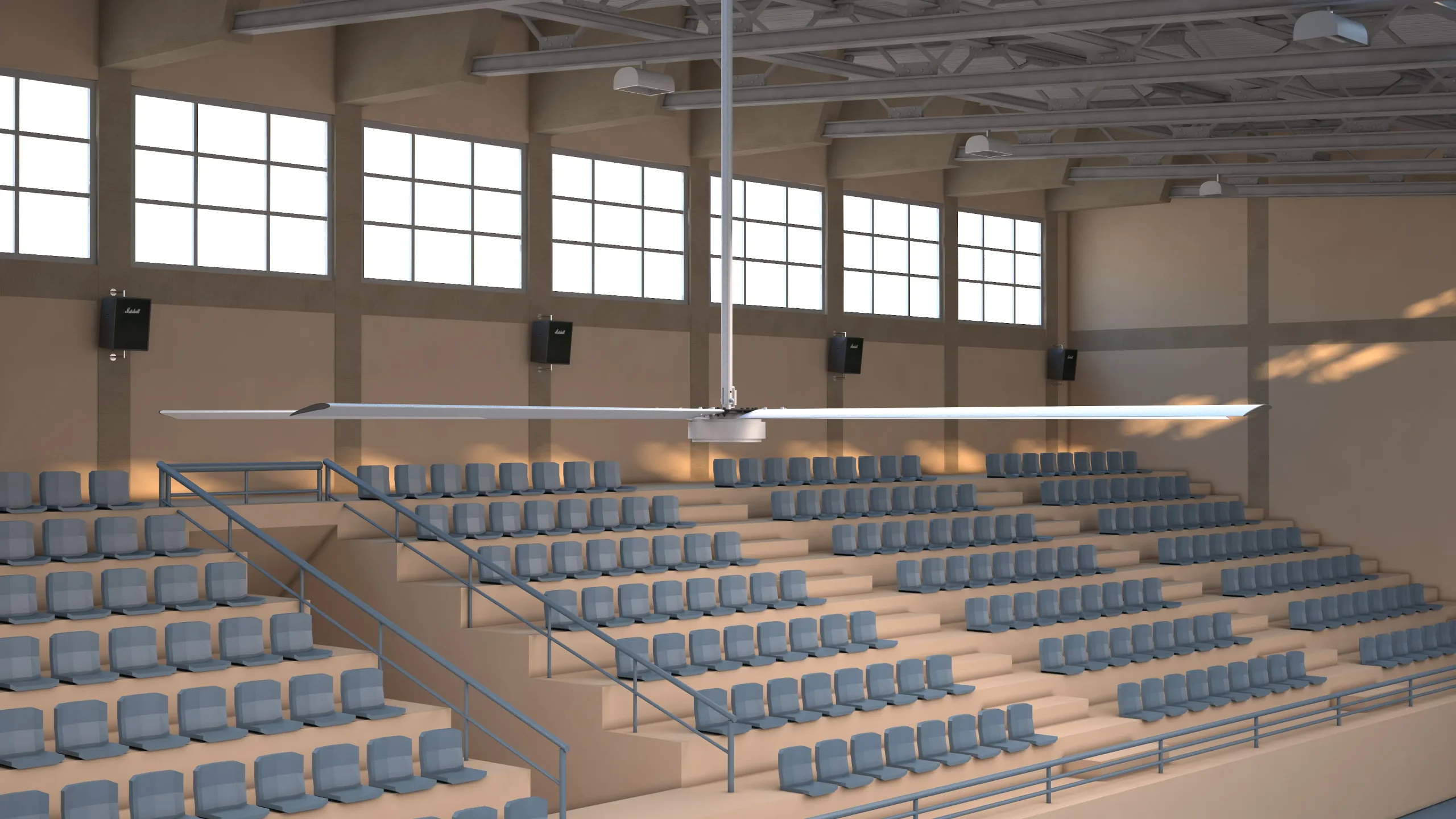Walk into any magazzino, fabbrica, O palestra on a hot day. You’ll feel it right away. Dead zones of stifling air. Hot spots near the ceiling. Cold pockets by the floor. Workers sweating. Energy bills soaring.
This isn’t just about comfort. It’s about money. Sicurezza. Produttività.
Large buildings face a brutal truth: traditional air systems fail. Small fans push air in circles. Sistemi HVAC work overtime but can’t move enough air. Energy costs spiral out of control.
The math is harsh. A typical magazzino wastes 30% of its cooling energy fighting poor circolazione dell'aria. Manufacturing facilities see worker productivity drop 15% in stagnant air zones. Edifici agricoli lose crops to humidity pockets.
But there’s a solution. Ventilatori a bassa velocità ad alto volume (HVLS) change everything.

HVLS fans for large buildings
HVLS fan installation starts with one question: Can your building handle it?
Altezza del soffitto matters first. Ventilatori HVLS need 12 feet minimum clearance. Most ventilatori da soffitto industriali work best at 16 to 30 feet high. Higher ceilings mean better airflow patterns.
Mounting systems come in three types:
Ogni Ventilatore HVLS weighs 200 to 400 pounds. Add dynamic forces from rotation. Your structure must handle 3 times the static weight.
Load-bearing verification isn’t optional. A structural engineer must sign off. Seismic zones need extra bracing. Building codes vary by location.
NFPA 13 sets the law for sprinkler systems. HVLS fan blades must stay 36 inches below any sprinkler head. No exceptions.
OSHA demands safe maintenance access. Service platforms O lifts must reach all fan components. Electrical disconnects go within sight of each fan.
Electrical codes specify three-phase power for most ventilatori HVLS commerciali. Variable frequency drives (VFDs) need dedicated circuits. Grounding follows NEC standards.
Certificazione UL ensures motor safety. CE compliance matters for international installations. Always check local building codes.
Fan spacing follows proven ratios. One Ventilatore HVLS covers 3 to 4 times its diameter on the floor. A 20-foot fan effectively cools 60 to 80 feet of floor space.
Airflow patterns create the real magic. Tecnologia HVLS pushes air down and out in a column. Air spreads across the floor then rises at walls. This creates natural circulation.
Collision zones kill efficiency. Map all overhead cranes, conveyors, E equipment. Blade clearance needs 7 feet minimum from any obstacle.
Door placement affects air exchange rates. Position fans to push air toward loading docks E ventilation openings. Work with existing Sistemi HVAC, not against them.
Ventilatori HVLS per magazzino applications show the best results with strategic placement near high-activity zones.
Target air velocity depends on use. Magazzini need 2 to 3 mph for comfort. Piani di produzione may want 4 to 6 mph for cooling. Edifici agricoli focus on air exchange.
Destratificazione breaks up temperature layers. Hot air rises and gets trapped near ceilings. Ventilatori HVLS mix air and create uniform temperatures throughout the space.
Energy savings calculations prove Ritorno sull'investimento. Studies show 20 to 30% HVAC energy reduction with proper HVLS installation. Payback periods range from 12 to 18 months.
Rigging protocols keep workers safe during ceiling installation. Heavy-duty lifts position fans precisely. Torque specifications ensure secure mounting.
Downrod length affects airflow optimization. Longer rods move fans further from ceilings. This improves circolazione dell'aria but requires more structural support.
Vibration dampeners prevent structural fatigue. Rubber isolators absorb motor vibrations. Flexible couplings protect electrical connections.
Dedicated circuits prevent voltage drops. HVLS motors draw high starting currents. Circuit breakers must handle motor surge.
Variable frequency drives offerta speed control. VFDs ridurre consumo di energia at lower speeds. They also provide soft starts that reduce mechanical stress.
Conduit systems protect wiring from ambienti industriali. EMT conduit works for most applications. Rigid steel conduit handles harsh conditions.
Laser-leveling ensures perfect fan alignment. Anche small angles cause wobbling. Precision mounting prevents bearing wear.
Dynamic balancing happens after installation. Vibration sensors detect imbalances. Weight adjustments su blade tips fix problems.
Testing procedures verify smooth operation. Run fans at full speed per 2 hours minimum. Monitor for unusual noises O vibrations.
Wall controllers provide basic speed control. Digital displays show operating status. Emergency stops garantire worker safety.
Building automation systems offer advanced control. Temperature sensors automatically adjust fan speeds. Sensori di occupazione turn fans on when needed.
Ventilatori da soffitto industriali per la produzione benefit most from integrated controls that respond to production schedules.

HVLS FAN Installation Process
Re-verify sprinkler clearance after final installation. Building inspectors check 36-inch minimums strictly. Violations stop occupancy permits.
Fire alarm systems may need updates. Fan motors shouldn’t interfere with smoke detection. Emergency procedures must account for spinning blades.
Blade tip clearance protects people and equipment. 7 feet minimum da walking surfaces. 10 piedi da work platforms provides extra safety.
Maintenance clearances garantire service access. Filter changes, lubrificazione, E inspections need adequate space. Plan for equipment removal during major repairs.
Seismic zones require special testing. Shake tables simulate earthquake forces. Mounting systems must meet local seismic codes.
Certification documents prove code compliance. Keep structural calculations, electrical permits, E inspection reports. Insurance companies often require these.
✗ Underestimating ceiling obstructions costs time and money. Ductwork, lighting, sprinklers, E cable trays complicate placement. Survey everything before final design.
✗ Incorrect spacing creates dead air zones. Too few fans leave punti caldi. Too many fans waste energia and create turbolenza.
✗ Ignoring maintenance access causes long-term problems. Service technicians need safe, easy access to motors, controlli, E lame.
✗ Skipping vibration testing leads to structural damage. Unbalanced fans destroy cuscinetti and crack mounting points. Always test thoroughly.
✗ Inadequate electrical sizing causes performance problems. Voltage drops ridurre motor efficiency. Undersized circuits trip breakers constantly.
✗ Poor alignment creates rumore E wear. Crooked installations stress components. Use precision tools per montaggio.
Ventilatori da soffitto HVLS from quality manufacturers reduce many installation risks through better engineering E clear instructions.
Research from multiple facilities shows consistent energy reductions:
Pennsylvania warehouse case study: 22% productivity gain con 11°F temperature reduction. ROI achieved in just 9 months.
Worker comfort improvements show dramatic results:
Dubai airplane hangar achieved humidity control below 60% RH, preventing $240,000 yearly In corrosion damage.
HVLS market size reached $1.28 billion in 2024. Projections show $2.3 billion by 2030 con 6.72% annual growth.
Key growth drivers:
High volume low speed fans for commercial applications lead market expansion.
Monthly checks prevent major problems:
Quarterly maintenance includes:
Dust accumulation reduces efficiency. Blade cleaning restores optimal airflow. Use mild detergent E soft brushes.
Industrial environments need frequent cleaning. Manufacturing dust, agricultural particles, E warehouse debris coat pale del ventilatore velocemente.
Energy meters track consumo di energia. Baseline measurements show efficiency changes. Increasing power use indicates maintenance needs.
Temperature logging proves continued performance. Hot spots returning suggests fan problems O changed airflow patterns.
Best HVLS fans include built-in monitoring systems for easier maintenance tracking.
Complex structures need expert installation:
Certified installers provide:
Installer qualifications matter:
Documentation requirements:
Modern HVLS fans integrate with building management systems. Temperature sensors automatically adjust fan speeds. Occupancy detection optimizes consumo di energia.
IoT connectivity enables remote monitoring. Smartphone apps controllare più fan. Data logging tracks performance trends.
Motori CE offerta precise speed control. Electronic commutation improves efficiency. Variable frequency drives ridurre consumo di energia A velocità più basse.
Automatic controls respond to changing conditions. Hot days get full speed cooling. Mild weather usi minimal energy.
Ventilatori HVLS con advanced controls show 35% better energy efficiency di basic models.

Sistemi di controllo intelligenti
AI-powered airflow mapping optimizes posizionamento del ventilatore automatically. Machine learning predicts maintenance needs. Predictive analytics prevent equipment failures.
Battery backup systems maintain circolazione dell'aria during power outages. Solar integration reduces costi operativi ulteriore.
Green building standards increasingly require efficient air movement. LEED certification rewards HVLS installations. Carbon reduction goals drive adoption.
Recyclable materials In fan construction meet sustainability targets. End-of-life programs maniglia component disposal responsibly.
HVLS fan installation per large buildings combines engineering precision con practical application. Structural analysis, safety compliance, E strategic placement determine success.
Key installation requirements:
Performance data proves HVLS effectiveness:
Produttore di ventilatori HVLS Tifosi di Vindus has documented similar results attraverso magazzino, produzione, E agricultural installations since 2019.
IL $2.3 billion projected market da 2030 reflects growing recognition Di HVLS benefits. Proper installation unlocks maximum performance, safety, E risparmio energetico per decades of reliable operation.
Avoid costly mistakes. Follow engineering principles. Verify compliance. Monitor performance. HVLS fan installation done right transforms large building environments Mentre delivering measurable returns su investment.
Scientific studies and case study data referenced throughout demonstrate proven performance attraverso multiple facility types E climate conditions. Installazione professionale following established protocols ensures optimal results E long-term reliability.

Ciao, sono Michael Danielsson, CEO di Vindus Fans, con oltre 15 anni di esperienza nel settore dell'ingegneria e della progettazione. Sono qui per condividere ciò che ho imparato. Se avete domande, non esitate a contattarmi in qualsiasi momento. Cresciamo insieme!